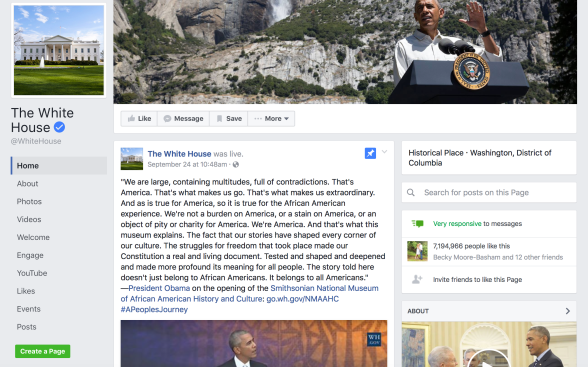What emerging media means for government public relations
Before the Web 2.0 era, citizens could reach out to government officials/agencies through traditional routes of phone or mail. Today, all it takes is an Internet connection. Through social media, citizens are engaging in an open environment where the government can not only share important information, but facilitate transparent, two-way conversation.
Research indicates that Americans are looking for this type of interaction as 14% use social media to find information about a federal agency, while 30% use social media to ask the government a direct question or to resolve an offline issue.
Tools used by the public sector may include social media platforms such as Facebook, the biggest social media network on the Internet. Through Facebook, governments can engage citizens, post events and news and share photos and short videos in real-time.
One example of the federal government working to communicate with constituents is The White House Facebook page. Through this medium, The White House provides live feed to events, creating a deeper connection between this high office and the people of America.
Twitter – a microblogging platform – is also important to sharing information with the public. For example, people who follow the Centers for Disease Control and Prevention (CDC) can find updates on the Zika virus, and can take part in conversations on public health concerns by using the hashtag #PublicHealthChat.

In addition, Twitter can be useful in communicating information during an emergency. One article notes a 2011 example in which Twitter helped notify residents of an earthquake before it hit. This allowed people to prepare for the shockwaves as the traditional alert system would take minutes (versus seconds).
YouTube
According to YouTube, a government entity can use this platform to “strengthen [its] online presence, control [its] story and engage [its] audience wherever they are.” Like Facebook and Twitter, this tool can be beneficial as government agencies work to connect with audiences and bridge the gap with the “more than 1 billion unique users [who] visit YouTube each month.”
One state agency using this forum is the West Virginia Department of Health and Human Resources. Through its YouTube channel, the Department works to highlight important services such as Help4WV, a 24-hour behavioral health hotline. It also posts each segment of its television show, “The State of Health.”
The agency also used emerging media tools to spread relevant information to residents impacted by the June 23 flooding. While internally DHHR shared information with workers in county offices via email and phone calls, the Department wanted to ensure that the those affected by the disaster were aware of resources that could help them. The Commissioner for the Bureau for Children and Families quickly recorded a special message which was posted to the Department’s social media accounts to spread awareness on a special program available to qualifying victims to help them replace food lost in the flood.
Implications of government social media
Facebook, Twitter and YouTube are just a few emerging media tools utilized by government agencies. These innovative platforms can be powerful in improving transparency and overall relations with the public. What do you think? Should all government agencies utilize these forums? Are there risks in using/not using them?


Great post. You are correct in that social media has not just changed individuals’ lives, but has changed the way government interacts with everyday citizens. It’s a great resource for not only federal and state agencies, but county and city as well. My local city puts out a weekly “News You Can Use” segment on Facebook and Twitter that is around three minutes long, and they cover everything from updates on construction projects, swimming pool safety for the public pools, how to register your storm cellar with emergency management, etc.
LikeLike
Thank you for your feedback, and for sharing an example of how a city can use social media to keep residents informed and engaged. I recently read an article that highlights how police departments can use social media to help track down fugitives/keep residents informed of local crimes. I think this is a helpful way to demonstrate police commitment to public safety. What do you think?
LikeLike
Jessica, nice post on governments’ use of social media. I think connecting with consumers via social media has become a must for most businesses including government agencies. Another interesting development is how political campaigns are using social media to contact and encourage supporters and to spread campaign messages, both negative and positive. It’s even more important for governmental agencies to have policies to handle negative posts, since politics brings out the best or worst of some commenters. As mentioned in a previous comment, local government can benefit from social media. For example, right now, all the local towns and counties are posting hurricane preparedness plans as we watch to see what Hurricane Matthew is doing. It’s a nice resource as the forecasts constantly change and helps us plan our activities, like getting to the grocery stores before the tourists. 🙂
LikeLike
Stephana: Thanks for sharing your thoughts! What about public information campaigns on social media? For example, have you been influenced by public health campaigns such as the Centers for Disease Control’s (CDC) efforts to increase awareness of issues such as the flu, zika virus, etc.?
LikeLike